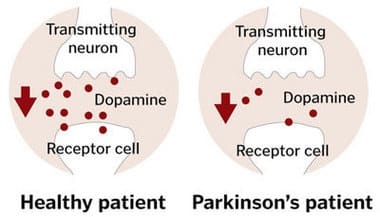
Cryotherapy: Potential Prevention & Treatment for Parkinson’s Disease
Parkinson’s disease (PD) is a long-term degenerative disorder of the central nervous system that mainly affects the motor system. Parkinson’s disease results from the death of cells in the substantia nigra region of the midbrain which causes insufficient dopamine production. Dopamine is the chemical messenger which coordinates smooth and balanced muscle movement.
Symptoms of Parkinson’s Disease:
- Motor problems: shaking, tremor, rigidity, slowness of movement (bradykinesia), difficulty walking, speech & voice disturbances, facial blankness;
- Cognitive: problems with planning,cognitive flexibility, abstract thinking, rule acquisition, inhibiting inappropriate actions and initiating appropriate actions, working memory, and selecting relevant sensory information;
- Depression, apathy, anxiety;
- Sensory, sleep, emotional problems;
- Dementia in advanced stages.
Parkinson’s Disease is not fully understood but researchers agree that there are several potential causes for the neuronal death that is a universal feature of the disease. Potential causes may be influenced by the interaction of:
- Genetics: those with a family member affected are more likely to get the disease themselves.
- Environmental: exposure to pesticides.
- Prior head injury.
The above circumstances increase the risk for developing Parkinson’s Disease. Neuronal death in this region may be due to:
- Build-up of alpha-synuclein proteins (called Lewy bodies) in these neurons. It is thought that some kind of immuno-incompetence develops whereby toxic synucleins are not detoxified from the brain. Synucleins then “aggregate” causing Lewy bodies. This immune-incompetence may be caused by localized neuroinflammation in the substantia nigra.
- Mitochondrial dysfunction.
- Oxidative stress.
- Neuroinflammation (specifically pro-inflammatory cytokines iNos, TNF, NFkb, IL-1B and IFN-g) which may act as blockades to typical neuroprotective pathways.
Researchers have found the following behaviors and interventions can reduce the risk for developing Parkinson’s Disease:
- Exercise in middle age reduces the risk of Parkinson’s disease later in life.
- Caffeine appears to be protective with a greater decrease in risk occurring with a larger intake of caffeinated beverages such as coffee.
- Tobacco smoke may reduce the risk of PD by a third when compared to non-smokers. Nicotine may act as a dopamine stimulant.
- Estrogen enhancement.
- Anti-inflammatory treatments.
Current treatments options for Parkinson’s Disease:
- Dopamine agonists (to increase dopamine levels);
- Anti-inflammatory diet & physical rehabilitation;
- Deep brain stimulation has been used to reduce motor problems;
- Anti-inflammatory treatments such as NSAIDS and whole body cryotherapy.
At Chill Cryotherapy we believe there is a potential role for whole body cryotherapy to assist in the prevention of Parkinson’s Disease.
- Neuroinflammation may play a role in the initiation of the disease itself by precipitating neuronal death in the substantia nigra. Malfunctioning immune cells called microglia may be activated through neuroinflammation. This neuronal death causes dopamine production to fall and signals the onset of disease and symptoms.
- α-synuclein accumulation is a universal feature of Parkinson’s Disease. α-synuclein accumulation may occur due to neuroinflammation which may prevent normal processes for disposing of toxic synucleins. Reducing neuroinflammation may delay or prevent the disease by maintaining normal disposal of toxic synucleins, avoiding aggregation and disease initiation.
- Peripheral and systemic inflammation have been significantly implicated in both the onset and progression of Parkinson’s disease. Systemic inflammation in the body can cross the blood-brain-barrier; once localized in the substantia nigra, PD may develop. Whole body cryotherapy can significantly reduce systemic and peripheral inflammation caused by auto-immune disorders, infection, injuries or other sources. By reducing inflammatory load throughout the body, we believe we can reduce the risk for developing Parkinson’s Disease.
At risk individuals (those with a family history, head injury or high exposure to pesticides) can benefit from whole body cryotherapy by reducing their systemic inflammatory load. Systemic inflammation may lead to localized neuroinflammation in the brain and has been implicated in several neurodegenerative disease such as Parkinson’s and Alzheimer’s Disease.
Note: Once the disease process has initiated, neuroinflammation and neuronal death create a vicious cycle which creates the degenerative, progressive nature of Parkinson’s Disease. Neuroinflammation may cause initial neuronal death; neuronal death leads to the emission of toxic biochemicals which activate even more neuroinflammation. This cycle is then self-perpetuating, leading to progressive neuronal degeneration in this area of the brain and symptom intensification.
The progressive nature of Parkinson’s based on this cycle of neuroinflammation and neuronal death suggests that preventative anti-inflammatory treatments earlier in life may have a protective role, prior to initiation of the disease. Anti-inflammatory treatments when the disease has progressed, are less effective because the vicious disease cycle of neuronal death and neuroinflammation has already taken hold.
At Chill Cryotherapy we believe there is a potential role for whole body cryotherapy to assist in the treatment of early stage Parkinson’s Disease.
- Progression of Parkinson’s may be delayed by reducing neuroinflammation. Dying neurons (a hallmark feature of PD) release toxic biochemicals (synuclein aggregates are an example) which trigger local inflammation. This neuroinflammation then precipitates more microglia activation and neuronal death and a vicious progressive cycle for the disease ensues. Once the disease is established, treatments modulating the inflammatory response may be the most promising means of slowing its progress.
- Anti-inflammatory treatments have been found to reduce anxiety, depression and apathy associated with Parkinson’s Disease. It is thought that anxiety, depression and apathy are inflammation-related. By reducing localized and systemic inflammation, these symptoms may improve, allowing for a better quality of life.
At Chill Cryotherapy we are committed to helping our clients prevent and treat Parkinson’s Disease with whole body cryotherapy. We believe whole body cryotherapy can reduce systemic inflammatory load, lowering the risk for developing the disease. Whole body cryotherapy has also been shown to reduce neuroinflammation by reducing inflammatory cytokines (specifically iNos, TNF, NFkb, IL-1B)—these cytokines have also been shown to be elevated in Parkinson’s Disease patients.
The Chill Cryotherapy medical advisor oversees our cryotherapy protocols for the prevention and treatment of Parkinson’s Disease. Please call us for more information about preventing and treating early-stage Parkinson’s Disease with whole body cryotherapy.
